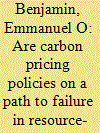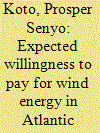| Srl | Item |
| 1 |
ID:
183562


|
|
|
|
|
| Summary/Abstract |
There are limited studies on specific factors that affect willingness-to-pay (WTP) and public concerns on spending of pollution pricing in democratic economies that are carbon dependent. In light of the discourse on global pollution pricing, this study explores the complex influence of political-economic, attitudinal, and socio-demographic factors on carbon pricing, by estimating the WTP in a carbon resource-dependent economy such as Canada and the preferred revenue earmarking of Canadians. An online survey of 600 Canadian households was conducted using the random device engagement (RDE) approach. This study uses a contingent valuation method (CVM) and payment card (P.C.) to estimate the household WTP for carbon pricing on direct energy expenditure and an ordered logistic regression model for odds ratio estimates. The estimated annual WTP ranges between CAD$ 84 to CAD$ 230 in 2019 (CAD$ 1 = US$ 0.7538). This implies an acceptable increment of 1.5%–2.5% (CAD$ 157 to CAD$ 259) to the average yearly household energy expenditures. This study suggests that Canadians appear to be supportive of redistributing carbon price revenues and investing in clean energy technology. Canadian government needs to address public concerns surrounding political-economic factors, specifically the energy cost implication for vulnerable households in order to achieve emission reduction targets.
|
|
|
|
|
|
|
|
|
|
|
|
|
|
|
|
| 2 |
ID:
169834


|
|
|
|
|
| Summary/Abstract |
The peer-to-peer (P2P) electricity trading platform (ETP) is an electricity-sharing system by which individuals can sell surplus electricity or purchase electricity to meet a deficit in a regional power network. South Korea has allowed energy prosumers to engage in electricity trading from 2016 and is seeking ways to vitalize the electricity trading market. This study aims to estimate the willingness to pay (WTP) of respondents for the monthly usage of P2P ETP by using the contingent valuation method. Of the 1000 Korean respondents, 639 were willing to pay a fee for using the platform. The estimated WTP is KRW 5958.86 (USD 5.50) per month. Moreover, the estimated WTP is higher in respondents who have more background knowledge of the P2P ETP and who pay higher electricity fees. The estimated WTP is lower than the usage fees of existing ETPs in other countries, which is primarily due to Korea's low electricity prices. Furthermore, the estimation results show that enhancing consumer awareness of P2P trading and introducing market strategies based on electricity usage should be considered by electricity trading companies and regulators to enhance P2P ETP usage.
|
|
|
|
|
|
|
|
|
|
|
|
|
|
|
|
| 3 |
ID:
166448


|
|
|
|
|
| Summary/Abstract |
We investigate the demand-side of wind energy in three provinces in Atlantic Canada, including New Brunswick, Nova Scotia and Prince Edward Island. Empirical questions addressed include: (i) What are the determinants of the probability of paying a non-zero premium for electricity generated using wind technology?; (ii) Given participation, what drives how much more households are willing to pay a month, and what is the monthly premium or expected willingness-to-pay (WTP)?; and (iii) Is there heterogeneity in the expected WTP? The study design follows the contingent valuation framework and the survey questionnaire follows a payment-scale format, reducing the starting point bias and reduces the incidence of item non-response. The data is from a stratified random sample. We employ two-stage models, Cragg's hurdle and the two-part econometric models in the analysis. Scope and 0 WTP effects are explicitly explored. We find that the overall probability of participation is 0.73. University education, income, residential property ownership, concerns about the presence of wind turbines in neighborhoods, and externality affect the likelihood of participation. Households are willing to pay 14% more per month in energy bill for wind power. There is evidence of scope sensitivity. The results provide insights on what proportion of the population will participate and how much more they are willing to pay for wind energy.
|
|
|
|
|
|
|
|
|
|
|
|
|
|
|
|
| 4 |
ID:
150862


|
|
|
|
|
| Summary/Abstract |
The paper examines the extent to which consumers' willingness-to-pay for energy-efficient room air conditioners may be altered by correcting the information inefficiency on the China Energy Label. The data are collected from a discrete choice experiment with two alternatives (variable-speed and constant-speed room air conditioners) characterized by attributes of brand, purchase price and energy grade. Three versions of the questionnaires with choice sets differing only in energy consumption indicators were distributed randomly to 1602 potential consumers in Nanjing, China and a sample of 1569 was obtained after dropping missing data. The analysis with multinomial and mixed logit models reveal that the price premium that consumers are willing to pay for a variable-speed room AC over a constant-speed room AC increases significantly when energy consumption information becomes comparable and additional energy-related information is provided. Furthermore, the impact of information on WTP varies under different energy-saving scenarios. It is suggested that China Energy Label should correct information inefficiency by adopting same energy indicators for room ACs with different technologies and providing energy consumption information based on different climate zones.
|
|
|
|
|
|
|
|
|
|
|
|
|
|
|
|